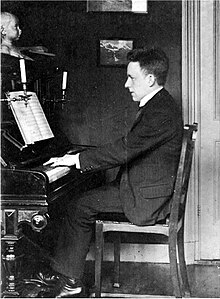Eduard Jan Dijksterhuis
Eduard Jan Dijksterhuis (born October 28, 1892 in Tilburg , † May 18, 1965 in De Bilt ) was a Dutch historian of science . Dijksterhuis is best known for his work on Archimedes and the historical study The Mechanization of the World View on the early history of mechanics.
Life
Dijksterhuis was the son of Berend Dijksterhuis (1861-1921) and Gezina Eerkes (1865-1936). The father was a geography teacher and principal of the high school (Rijkshogereburgerschool, RHBS) in Tilburg and had received his doctorate in 1899 with a historical thesis. Eduard Jan Dijksterhuis studied mathematics at the University of Groningen from 1911 to 1918 . In 1918 he received his doctorate with the text Bijdragen tot de kennis from meetkunde van het platte schroevenvlak (geometry of the screw surface ). He then taught mathematics , physics and cosmography until 1953 . First he was a mathematics teacher at the girls' high school in Groningen from 1916 to 1918 and at the RHBS Willem II in Tilburg from 1919 to 1953. From 1934 to 1958 he headed the Dutch Onderwijsraad, which advises the government on educational issues. From 1940 to 1960 he was the editorial secretary of the literary newspaper De Gids , for which he wrote numerous articles on a wide variety of topics. He was active in reforming the teaching of mathematics and mechanics in Dutch schools and advocated the consideration of the history of mathematics in the classroom (the title of his collection of essays, Clio`s Stiefkind, alludes to an essay by Dijksterhuis on the neglect of the history of science in teaching in the Netherlands).
After he had previously been a private lecturer in Amsterdam and from 1932 to 1936 in Leiden, he went to the University of Utrecht as a professor in 1953 and to the University of Leiden in 1955 . He taught the history of mathematics and the history of science at both universities . When he became a full professor in Utrecht in 1960, he gave up the chair in Leiden. He held his chair until 1963. In 1959 Dijksterhuis suffered a stroke from which he could no longer properly recover. He died six years later at the age of 72.
Dijksterhuis had been married to Johanna Cathinka Elisabeth Niemeijer since 1920, with whom he had two sons and a daughter.
For his main work, Die Mechanisierung des Weltbildes , published in Dutch in 1950, he received the then Dutch State Prize for Literature ( PC Hooft-prijs ) in 1951 . A German translation appeared in 1956 and an English translation in 1961. It traces the history of the mechanical worldview (astronomy, physics, chemistry) from antiquity to Newton.
In 1952 the scientist was accepted into the Royal Dutch Academy of Sciences . He was a member of the Simon Stevin Commission of the Dutch Academy of Sciences and was involved in the publication of the first volume of his works in 1955. In 1962, he was the George Sarton Medal Award, the prestigious award for the History of Science that of George Sarton and Lawrence Joseph Henderson founded History of Science Society (HSS).
Dijksterhuis was in scientific correspondence with the physicist and science historian Hans Schimank . The letters are preserved in Schimank's extensive estate.
literature
- Klaas van Berkel: Dijksterhuis. A biography , Amsterdam 1996
- Karl-Eugen Kurrer : The History of the Theory of Structures. Searching for Equilibrium . Ernst & Sohn , Berlin 2018, p. 376 a. 986f. (Biography), ISBN 978-3-433-03229-9 .
Footnotes
- ^ University of Hamburg, The correspondence from Hans Schimank
Works
- Val en Worp. Een bijdrage tot de geschiedenis der mechanica van Aristotle tot Newton . Groningen 1924.
- Archimedes . Groningen, 1938, English translation Copenhagen 1956.
- De elements van Euclides . 2 volumes, Groningen, 1929–1930 (Commentary on Euclid's Elements).
- The mechanization of the worldview . Springer, Berlin / Heidelberg / New York, 1956, reprint 1983, ISBN 3-540-02003-9 (German translation; English translation: Oxford University Press 1961; original 1950: De mechanisering van het wereldbeeld , Meulenhof, Amsterdam, reprint 1980) .
- Vreemde was in de wiskunde . Groningen 1939.
- Betekenis van de wis- en natuurkunde voor het leven en think van Blaise Pascal . 1952.
- Simon Stevin . s´Gravenhage 1943 (English translation: Simon Stevin: Science in the Netherlands around 1600 , s´Gravenhage 1970).
- Betekenis van de wis- en natuurkunde voor het leven en think van Blaise Pascal . 1952.
- as publisher Scientia: handboek voor wetenschap, kunst en religie in 3 delen . De Haan, 1956-1957.
- Clio's stepchild . Amsterdam, Bakker 1990 (essays, edited and with an introduction by K. van Berkel).
- as editor: Antieke en Moderne Kosmologie . Arnhem 1941.
- The mechanization of the worldview . Physikalische Blätter, Volume 12, 1956, pp. 481-494 (lecture Bremen 1951), doi : 10.1002 / phbl.19560121101 .
Web links
- Literature by and about Eduard Jan Dijksterhuis in the catalog of the German National Library
- R. Hooykaas: Dijksterhuis, Eduard Jan (1892-1965) . In: Biographical Woordenboek van Nederland. (Dutch).
| personal data | |
|---|---|
| SURNAME | Dijksterhuis, Eduard Jan |
| BRIEF DESCRIPTION | Dutch historian of science and essayist |
| DATE OF BIRTH | October 28, 1892 |
| PLACE OF BIRTH | Tilburg , Netherlands |
| DATE OF DEATH | May 18, 1965 |
| Place of death | De Bilt , Netherlands |
